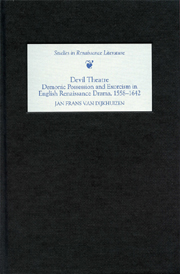CHAPTER THREE - POSSESSION, EXORCISM AND THEATRE
Published online by Cambridge University Press: 12 September 2012
Summary
In early modern culture, rituals of exorcism were public events, which drew crowds. During Mary Glover's exorcism in London in 1602, Stephen Bradwell reports, groups of spectators, ‘sometimes by troupes of 8 or 10 at once,’ would walk in and out. John Darrel writes that there were ‘some 60’ spectators present at the exorcism of William Somers. In his account of the exorcism of Madeleine de Demandouls and Louise Capeau, Sebastien Michaëlis reports that ‘great troupes did daily flocke thither’ to marvel at the spectacular symptoms of the two nuns, and to listen to the sermons uttered by the possessing devil, Verrine.
During his affliction by the devil, William Somers acted out the sins of Nottingham as a warning against the moral deterioration of this town. In his account of the Somers case, Samuel Harsnett comments sardonically on William's ‘signes and gestures,’ taken by those present ‘to signifie the particular sinnes raigning in those places, where the possessed be.’ Exorcism here served as a form of didactic religious drama. It represented a public struggle between God and the devil, in which spectators could recognise their own spiritual conflicts. In a similar manner, the crowd described by Michaëlis responded to the exorcisms as though they were watching a representation of their own sins:
All the assembly were so affrighted […] at the dreadfull passages which Verrine had, touching the paines of hell that there gushed from their eyes abundance of teares, when they called to remembrance their offences which they had committed.
- Type
- Chapter
- Information
- Devil TheatreDemonic Possession and Exorcism in English Renaissance Drama, 1558–1642, pp. 153 - 186Publisher: Boydell & BrewerPrint publication year: 2007



